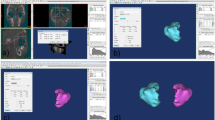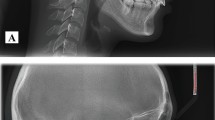Abstract
Purpose
To investigate whether there is a relationship between the volume of the maxillary sinus and individual parameters such as gender, side, posterior tooth absence, sinus membrane thickening, bony septa, vertical and sagittal skeletal patterns.
Methods
The tomographic volume of the maxillary sinus from 211 individuals (422 sides) was evaluated using Horos DICOM Viewer Software. Bony septa and sinus membrane thickening were classified as absent or present. At the same time, loss of one or more teeth in the posterior region of the maxilla (except for the third molars) was considered. The t test was applied to analyze maxillary sinus volume according to gender, age, side, posterior tooth absence, sinus membrane thickening and bony septa. A one-way analysis of variance (ANOVA) with Tukey’s post-hoc test was applied to compare sagittal and vertical patterns. Pearson’s correlation coefficient was also used to verify the association between maxillary sinus volume, age and skeletal patterns.
Results
Concerning the sagittal skeletal pattern, a statistically significant difference was observed between Classes II and III (p = 0.05) and it was confirmed by the Pearson’s correlation coefficient (r = − 0.107/p = 0.029). No statistically significant differences were observed between the maxillary sinus volume according to gender (p = 0.06), side (p = 0.37), posterior tooth absence (p = 0.92), sinus membrane thickening (p = 0.47), bony septa (0.89) and vertical skeletal pattern (p = 0.67). No significant differences were observed with age (r = − 0.076/p = 0.109) and the vertical skeletal pattern (r = − 0.078/p = 0.108).
Conclusion
Maxillary sinus volume was influenced by the sagittal skeletal pattern and was higher in Class III individuals.

Similar content being viewed by others
Data availability
The datasets generated during and/or analysed during the current study are available from the corresponding author on reasonable request.
References
Ahmed M, Shaikh A, Fida M (2016) Diagnostic performance of various cephalometric parameters for the assessment of vertical growth pattern. Dental Press J Orthod 21:41–49. https://doi.org/10.1590/2177-6709.21.4.041-049
Barghouth G, Prior JO, Lepori D, Devoisin B, Schnyder P, Gudinchet F (2002) Paranasal sinuses in children: Size evaluation of maxillary, sphenoid, and frontal sinuses by magnetic resonance imaging and proposal of volume index percentile curves. Eur Radiol 12:1451–1458. https://doi.org/10.1007/s00330-001-1218-9
Esenlik E, Sabuncuoglu FA (2012) Alveolar and symphysis regions of patients with skeletal class ii division 1 anomalies with different vertical growth patterns. Eur J Dent 6:123–132
Gaia BF, Pinheiro LR, Umetsubo OS, Costa FF, Cavalcanti MGP (2014) Validity of three-dimensional computed tomography measurements for Le Fort I osteotomy. Int J Oral Maxillofac Surg 43:197–203. https://doi.org/10.1016/j.ijom.2013.06.005
Goller-Bulut D, Sekerci AE, Kose E, Sisman Y (2015) Cone-beam computed tomographic analysis of maxillary premolars and molars to detect the relationship between periapical and marginal bone loss and mucosal thickness of m sinus. Med Oral Patol Oral Cir Bucal 20:572–579. https://doi.org/10.4317/medoral.20587
Gulec M, Tassoker M, Magat G, Lale B, Ozcan S, Orhan K (2020) Three-dimensional volumetric analysis of the maxillary sinus: a cone-beam computed tomography study. Folia Morphol (Warsz) 79:557–562. https://doi.org/10.5603/FM.a2019.0106
Hung K, Montalvao C, Yeung AWK et al (2020) Frequency, location, and morphology of accessory maxillary sinus ostia: a retrospective study using cone beam computed tomography (CBCT). Surg Radiol Anat 42:219–228. https://doi.org/10.1007/s00276-019-02308-6
Hungerbühler A, Rostetter C, Lübbers HT, Rücker M, Stadlinger B (2019) Anatomical characteristics of maxillary sinus septa visualized by cone beam computed tomography. Int J Oral Maxillofac Surg 48:382–387. https://doi.org/10.1016/j.ijom.2018.09.009
Iwanaga J, Tanaka T, Ibaragi S et al (2020) Revisiting major anatomical risk factors of maxillary sinus lift and soft tissue graft harvesting for dental implant surgeons. Surg Radiol Anat 42:1025–1031. https://doi.org/10.1007/s00276-020-02468-w
Janner SF et al (2011) Characteristics and dimensions of the Schneiderian membrane: a radiographic analysis using cone beam computed tomography in patients referred for dental implant surgery in the posterior maxilla. Clin Oral Implants Res 22:1446–1453
Jun BC, Song SW, Park CS, Lee DH, Cho KJ, Cho JH (2005) The analysis of maxillary sinus aeration according to aging process; volume assessment by 3-dimensional reconstruction by high-resolution CT scanning. Otolaryngol - Head Neck Surg 132:429–434. https://doi.org/10.1016/j.otohns.2004.11.012
Koo TK, Li MY (2016) A guideline for selecting and reporting intraclass correlation coefficients for reliability research. J Chiropr Med. Elsevier BV 15:155–163. https://doi.org/10.1016/j.jcm.2016.02.012
Lorkiewicz-Muszyńska D, Kociemba W, Rewekant A, Sroka A, Jończyk-Potoczna K, Patelska-Banaszewska M et al (2015) Development of the maxillary sinus from birth to age 18. Postnatal growth pattern. Int J Pediatr Otorhinolaryngol 79:1393–1400. https://doi.org/10.1016/j.ijporl.2015.05.032
Maestre-Ferrín L, Galán-Gil S, Rubio-Serrano M, Peñarrocha-Diago M, Peñarrocha-Oltra D (2010) Maxillary sinus septa: a systematic review. Oral Patol Oral Cir Bucal 15:383–389. https://doi.org/10.4317/medoral.15.e383
Monsour PA, Dudhia R (2008) Implant radiography and radiology. Australian Dent J 53:11–25
Nucera R, Bellocchio AM, Oteri G, Farah AJ, Rosalia L, Giancarlo C, Portelli M (2019) Bone and cortical bone characteristics of mandibular retromolar trigone and anterior ramus region for miniscrew insertion in adults. Am J Orthod Dentofacial Orthop 155:330–338. https://doi.org/10.1016/j.ajodo.2018.04.025
Okşayan R, Sökücü O, Yeşildal S (2017) Evaluation of maxillary sinus volume and dimensions in different vertical face growth patterns: a study of cone-beam computed tomography. Acta Odontol Scand 75:345–349. https://doi.org/10.1080/00016357.2017.1310294
Oktay H (1992) The study of the maxillary sinus areas in different orthodontic malocclusions. Am J Orthod Dentofac Orthop 102:143–145. https://doi.org/10.1016/0889-5406(92)70026-7
Oliveira JMM, Alonso MBCC, de Sousa TMJAP, Fuziy A, Scocate ACRN, Costa ALF (2017) Volumetric study of sphenoid sinuses: anatomical analysis in helical computed tomography. Surg Radiol Anat 39:367–374. https://doi.org/10.1007/s00276-016-1743-5
Pauwels R (2015) Cone beam CT for dental and maxillofacial imaging: dose matters. Radiat Prot Dosimetry 165:156–161. https://doi.org/10.1093/rpd/ncv057
Przystańska A, Kulczyk T, Rewekant A, Sroka A, Jończyk-Potoczna K, Lorkiewicz-Muszyńska D et al (2018) Introducing a simple method of maxillary sinus volume assessment based on linear dimensions. Ann Anat 215:47–51. https://doi.org/10.1016/j.aanat.2017.09.010
Sadek MM, Sabet NE, Hassan IT (2016) Three-dimensional mapping of cortical bone thickness in subjects with different vertical facial dimensions. Prog Orthod 17:1–7. https://doi.org/10.1186/s40510-016-0145-x
Sakhdari S, Panjnoush M, Eyvazlou A, Niktash A (2016) Determination of the prevalence, height, and location of the maxillary sinus septa using cone-beam computed tomography. Dental Implant 25:335–340. https://doi.org/10.1097/ID.0000000000000380
Schriber M, Bornstein MM, Suter VGA (2019) Is the pneumatization of the maxillary sinus following tooth loss a reality? A retrospective analysis using cone-beam computed tomography and a customized software program. Clin Oral Investig 23:1349–1358. https://doi.org/10.1007/s00784-018-2552-5
Shrestha B, Shrestha R, Lin T, Lu Y, Lu H, Mai Z, Ai H (2021) Evaluation of maxillary sinus volume in different craniofacial patterns: a CBCT study. Oral Radiol 37:647–652. https://doi.org/10.1007/s11282-020-00506-2
Steiner CC (1953) Cephalometrics for you and me. Am J Orthod Dentofacial Orthop 39:729–755
Sun Y, Luebbers HT, Agbaje JO, Schepers S, Vrielinck L, Lambrichts I et al (2013) Accuracy of upper jaw positioning with intermediate splint fabrication after virtual planning in bimaxillary orthognathic surgery. J Craniofac Surg 24:1871–1876. https://doi.org/10.1097/SCS.0b013e31829a80d9
Talo Yildirim T, Güncü GN, Colak M, Nares S, Tözüm TF (2017) Evaluation of maxillary sinus septa: a retrospective clinical study with cone beam computerized tomography (CBCT). Eur Rev Med Pharmacol Sci 21:5306–5314. https://doi.org/10.26355/eurrev_201712_13912
Tavares A, Crusoé-Rebello IM, Neves FS (2020) Tomographic evaluation of infra zygomatic crest for orthodontic anchorage in different vertical and sagittal skeletal patterns. J Clin Exp Dent 12:1015–1035. https://doi.org/10.4317/jced.57267
Tawfik D, El Shourbagy E, Ghobashy S (2016) Calvarial thickness in relation to sagittal and vertical malrelations in Egyptians. Tanta Dent J 13:34–40
Underwood AS (1910) An inquiry into the anatomy and pathology of the maxillary sinus. J Anat Physiol 44:354–369
Velasco-Torres M, Padial-Molina M, Avila-Ortiz G, García-Delgado R, O’Valle F, Catena A, Galindo-Moreno P (2017) Maxillary sinus dimensions decrease as age and tooth loss increase. Dental Implant 26:288–295. https://doi.org/10.1097/ID.0000000000000551
Weiss R, Read-Fuller A (2019) Cone beam computed tomography in oral and maxillofacial surgery: an evidence-based review. Dent J 7:52–75. https://doi.org/10.3390/dj7020052
Acknowledgements
Not applicable.
Funding
The authors did not receive support from any organization for the submitted work.
Author information
Authors and Affiliations
Contributions
AMGL: manuscript writing and editing, Data analysis. VSO: protocol/project development and manuscript writing. RBAC: data collection or management. ATRM: data analysis. IMCR: data collection. FWGC: manuscript editing. FSN: project development, data collection, manuscript writing. All authors approved the final version of the manuscript.
Corresponding author
Ethics declarations
Conflict of interest
The authors have no conflict of interest to declare that are relevant to the content of this article.
Ethics approval and consent to participate
This study was approved by the ethical review commission of the Research Ethics Committee the Local Research Ethics Committee (nº 1.208.317), CAAE 43745915.9.0000.5024. All participants signed or consent form.
Consent for publication
All authors agree to publish this article and the data contained therein.
Additional information
Publisher's Note
Springer Nature remains neutral with regard to jurisdictional claims in published maps and institutional affiliations.
Rights and permissions
Springer Nature or its licensor (e.g. a society or other partner) holds exclusive rights to this article under a publishing agreement with the author(s) or other rightsholder(s); author self-archiving of the accepted manuscript version of this article is solely governed by the terms of such publishing agreement and applicable law.
About this article
Cite this article
Lessa, A.M.G., Oliveira, V.S., Costa, R.B.A. et al. Anatomical study of the maxillary sinus: which characteristics can influence its volume?. Surg Radiol Anat 45, 81–87 (2023). https://doi.org/10.1007/s00276-022-03055-x
Received:
Accepted:
Published:
Issue Date:
DOI: https://doi.org/10.1007/s00276-022-03055-x




